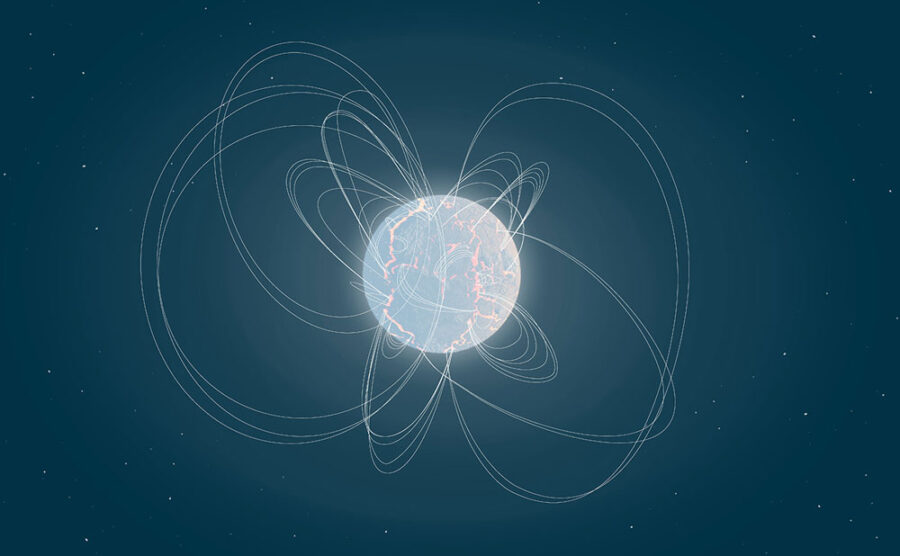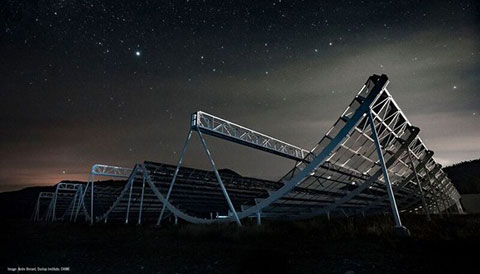This week, astronomers announce a newborn magnetar and a fast radio burst that’s bursting to a beat.
Newborn Magnetar

ESA
Around the time of the American Revolutionary War, a star exploded in the constellation Sagittarius, some 16,000 light-years away. The supernova left behind a burnt cinder, the just-discovered neutron star known as Swift J1818.0-1607.
Astronomers spotted this source of X-ray flashes on March 12, 2020, using NASA's Neil Gehrels Swift Observatory, an X-ray satellite. NuSTAR and the European Space Agency's XMM-Newton soon confirmed the discovery and helped astronomers understand what it was.
The collapsed stellar core squeezes two Suns' worth of mass into a sphere that could fit the length of Manhattan across it. Amazingly, that compact bulk spins around every 1.36 seconds. The object is ultramagnetized, with some 1,000 times the strength of a typical neutron star's magnetic field. This puts it into the class of magnetars, making it only the 31st member of this elusive class.
What's more, the magnetar is young. At only 240 years old, it's the youngest one known — a fledgling by astronomical standards. It could give astronomers a unique view on how such objects form. But first, the researchers will need additional measurements of the magnetar's spin; its almost-imperceptible slowdown is what enables astronomers to estimate its age.
Read more in NASA/JPL-Caltech's press release and in the preprint of the study, which Paolo Esposito (IUSS - School for Advanced Studies, Italy) and colleagues will publish in the Astrophysical Journal Letters.
Radio Bursts with a Beat

McGill University
Fast radio bursts (FRBs) are brilliant, millisecond-long flashes of radio waves that mostly come from distant sources. What makes the flashes is still unknown.
The goal of the Canadian Hydrogen Intensity Mapping Experiment (CHIME) FRB Project is to amass as many of these sources as the radio array can find. The most active source in the CHIME catalog is designated FRB 180916.J0158+65. Back in January, astronomers announced they'd pinpointed its location in the outskirts of a nearby spiral galaxy.
Now, the CHIME/FRB collaboration has realized there's a rhythm to the 38 bursts recorded in the two years since the FRB's discovery.
Every 16 days, the source starts acting up, emitting roughly a burst every hour for a period of about five days. Then it's silent for the next 11 days or so before starting the cycle over again. The beat seems too long to be associated with the rotation of an object such as a neutron star. Instead, the researchers suggest, a stellar companion could be driving the beat.
This is the first FRB with a steady cadence to its bursts, but it could be that astronomers just haven't yet detected the beat of other FRBs.
Read more in the press releases issued by Yale and MIT, as well as the study published in Nature.
 5
5









Comments
Joe
June 18, 2020 at 9:23 pm
I’m just getting into astronomy and need a little help with the article. I assume the supernova was seen from Earth at the time of the American Revolutionary War, but it actually occurred 16,000 years before. Correct? I kept trying to figure out how the radio signal covered 16,000 light years in a mere 240 Earth years!
You must be logged in to post a comment.
Monica YoungPost Author
June 18, 2020 at 9:43 pm
That's exactly right: Earthlings would have seen the supernova 240 years ago, but the actual supernova occurred 16,240 years ago (or so).
You must be logged in to post a comment.
Joe
June 19, 2020 at 8:57 am
Thanks! I really enjoyed your article!
You must be logged in to post a comment.
Anthony Barreiro
June 19, 2020 at 5:11 pm
If I understand special relativity correctly, the supernova happened 240 years ago in the frame of reference of an observer here on Earth and 16,240 years ago in the frame of reference of an observer at the supernova (that observer and their timepiece were unfortunately blown to smithereens). And in the frame of reference of a photon travelling at the speed of light from the supernova to Earth, departure and arrival happened at the exact same moment (unless the photon hit some dust and slowed down along the way).
I found Sean Carroll's book "From Eternity to Here: The Quest for the Ultimate Theory of Time" very helpful in understanding this mind-bending concept, among others.
You must be logged in to post a comment.
rjdennis
June 19, 2020 at 10:29 pm
As I understand the press release the star is 16000 light years away, the event happened 16000 years ago when the star was about 240 years old as a magnatar. I think Einstein would agree.
You must be logged in to post a comment.
You must be logged in to post a comment.